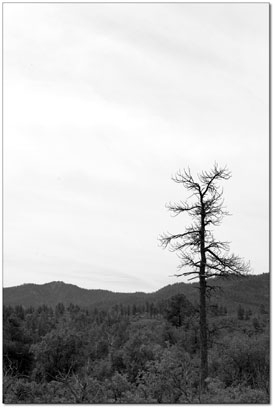| ||
| Unhappy hunting grounds Hunting interests and drilling increasingly at odds SideStory: Another cost of energy development
by Will Sands Hunting season is again upon the San Juan Mountains, and bowhunters are currently working the local backcountry in search of game. But in the public lands picture, hunters and outfitters are more likely to stumble upon natural gas wells than trophy animals. With increasingly aggressive oil and gas development throughout the West, the two uses of public land are not mixing well. Spurred by higher prices and record profits, energy companies are drilling and extracting natural gas and oil at unprecedented rates. More than 50,000 new wells are forecasted in Colorado over the next 20 years, and drill rigs, pump-jacks and new roads are pushing into prime habitat for deer, elk and other wildlife and closer to trout streams. In response, sportsmen are beginning to speak up. Last month, a coalition of hunters and anglers joined with conservationists and called the energy industry to task. Spearheaded by the Colorado Wildlife Federation and the Colorado Mule Deer Association, more than a dozen groups asked federal and state agencies to impose strict guidelines on the oil and gas industry. “As sportsmen and Coloradans, we can no longer stand by and watch as our wildlife and hunting and fishing traditions are needlessly sacrificed simply to add a few more dollars to the accounts of energy companies already making record profits,” said Bob Elderkin, of the Colorado Mule Deer Foundation. Unorthodox alliances are also beginning to form as the result of ramped-up energy development. Sportsmen and environmental groups, once at odds, have joined forces to protect Colorado’s prime habitat. “Conservation organizations are joining with sportsmen because we all recognize the threat oil and gas development places on our state’s wildlife and all natural resources,” said Clair Bastable, of the Colorado Mountain Club. “There’s an obvious need for us to work as allies because we all care so deeply about our wildlife and the heritage and traditions these species represent.” In La Plata County, hunting and energy development are most divisive in the HD Mountains. The San Juan Public Lands Center recently released its preferred alternative for natural gas exploration in the 28,000-acre HD Mountains Roadless Area. The plan would open up 20,000 acres of the HD Mountains Roadless Area to natural gas development, including 57 well pads and 38 miles of new roads. “Energy development is becoming a major concern for outfitters,” commented Brian O’Donnell, director of Trout Unlimited’s Public Lands Initiative. “We’re seeing that locally with the HD Mountains, on the Roan Plateau near Grand Junction and up and down the Rocky Mountains. It’s great to see outfitters rally to defend the places they rely on.” Mike Murphy, owner of T Bar M Outfitters, has long operated in the HD Mountains. He noted that roadless areas offer one of the best and last sanctuaries for large herds and that opening them up to energy development is irresponsible. “Not only is hunter success greater on roadless lands, but these lands provide summer feeding and nursery grounds to ensure we’ll have good hunting come fall,” Murphy said. “The more we encroach on roadless lands, the more pressure we put on elk and deer in Colorado, and the harder it becomes to find quality hunting.” Mark Pearson, executive director of San Juan Citizens Alliance, concurred that oil and gas development is not appropriate in roadless areas. He also noted that outfitters, sportsmen and the Division of Wildlife are rallying to protect these endangered places. “If in every valley and on every hilltop, there are gas compressors, new roads and company trucks driving back and forth, that clearly damages the primitive hunting experience,” he said. “I think that’s why sportsmen and the Division of Wildlife came out so strongly in favor of preserving roadless areas. There’s only so much, and when it’s gone, it’s gone.” O’Donnell pushed the onus back on the regulatory agencies. He noted that outfitters have been operating successful businesses and contributing to local economies for generations. “Places that outfitters have taken clients for generations have suddenly been leased,” he said. “These people’s concerns and livelihoods are taking a backseat to the energy industry.” One agency counters that it is trying to do a better job with outfitters. The Bureau of Land Management recently signed a memorandum of understanding with the Colorado Outfitters Association and is taking concrete steps to ensure that outfitters concerns are heard. “The MOU is basically an overarching document that says we’re going to become partners and work together,” explained Kay Hopkins, a BLM outdoor recreation planner. “With the increased amount of energy development in the West, we are seeing more impacts to people conducting business on public lands. We need to keep the stakeholders involved, and if we can mitigate impacts to them, we will.” Though he recognizes the effort, O’Donnell is skeptical. He charged that it’s time for agencies to go beyond just recognizing other uses. The BLM and Forest Service now need to begin prioritizing something other than extraction. “Clearly there’s been pressure to drill in as many places as possible. As a whole, the agencies aren’t doing enough to protect fish and wildlife,” O’Donnell said. “Right now, we’re still in a situation where energy use is trumping all other uses of public lands.” Elderkin, of the Colorado Mule Deer Foundation, agreed, concluding, “Drilling companies know how to avoid these impacts and are developing new technology all the time. But they won’t do it unless our federal and state agencies require it.” •
|


